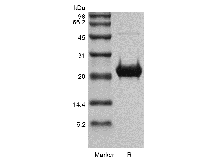Human FGF-19 is encoded by the FGF19 gene. FGF-19 belongs to the FGF-19 subfamily which has three members FGF-19, 21, 23. FGFs are classically considered to be paracrine factors and are known for their roles in tissue patterning and organogenesis during embryogenesis. By contrast, the FGF-19 subfamily has recently been shown to function in an endocrine manner. Members of this subfamily have poor ability of binding to heparin binding site which is a crucial factor in ligand-receptor complex formation. β-Klotho has been identified as co-factor required for FGF-19, 21, 23 signaling. It can obviously increase ligand-receptor affinity. Unlike most FGFs which bind to and activate more than one FGF receptor, FGF19 is a specific ligand for FGF R4. In FGF-19 transgenic mice, reducing liver triglycerides, increasing fatty acid oxidation, reducing glucose levels and improving insulin sensitivity can be observed.

